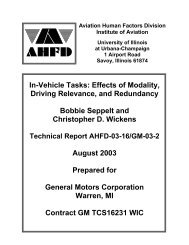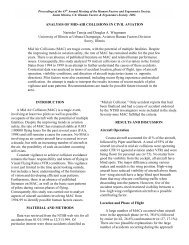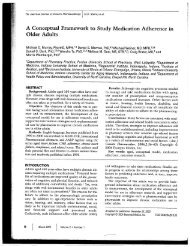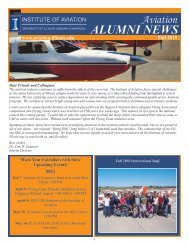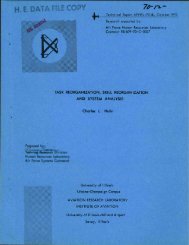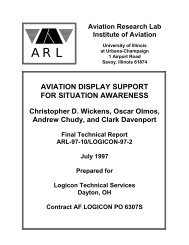Usability Questionnaire Results - Institute of Aviation - University of ...
Usability Questionnaire Results - Institute of Aviation - University of ...
Usability Questionnaire Results - Institute of Aviation - University of ...
You also want an ePaper? Increase the reach of your titles
YUMPU automatically turns print PDFs into web optimized ePapers that Google loves.
2.2.1 Mimic DisplaysMimic displays present information at the level <strong>of</strong> physical function <strong>of</strong> a system (Hollan,Hutchins, McCandless, Rosenstein, & Weitzman, 1987; Bennett, 1993; Bennett & Malek, 2000).A mimic display provides representations <strong>of</strong> important components, systems, or subsystems asthey appear in the physical world. For example, a mimic display <strong>of</strong> an automobile’s fuel systemwould include a schematic outline <strong>of</strong> the vehicle with a fuel tank and gas lines and valvessuperimposed. The level <strong>of</strong> fuel would be indicated in the gas tank representation.A particularly good feature <strong>of</strong> mimic displays is their ability to show physicalconnections and limiting problems <strong>of</strong> the important components or systems. These provisionslead to better support for detection and diagnosing <strong>of</strong> faults in a system (Bennett & Malek,2000). Animation in mimic displays has also been achieved to provide additional informationabout the flow <strong>of</strong> information and resources within a system (Bennett, 1993; Bennett & Malek,2000). Part <strong>of</strong> the benefit <strong>of</strong> mimic displays comes from their pictorial realism. This refers to adisplay representation being a pictorial representation <strong>of</strong> the entity it is representing (Wickens &Hollands, 2000).Moray and Rotenberg (1989) used a type <strong>of</strong> a mimic display to display the operation <strong>of</strong> asimulated thermal hydraulic system. Participants in the experiment saw a physical representation<strong>of</strong> the thermal hydraulic system. Temperatures and the level <strong>of</strong> fluid in the tanks were directlydisplayed to aid the operator’s mental model <strong>of</strong> the current state <strong>of</strong> the system. This wasintended to aid the operator in both detection <strong>of</strong> faults in the process control and diagnose theproblems.Mimic displays are one useful way to represent information about a system. However,mimic displays do not address the issue <strong>of</strong> integrating information. The discussion will now turnto integrated displays to discuss the integration issue.2.2.2 Integrated DisplaysThe trend for displays over recent years has been to integrate various sources <strong>of</strong>information into one display referred to as integrated displays. Integrated displays can bedefined as any type <strong>of</strong> display that integrates multiple sources <strong>of</strong> information into one format ordisplay. One component <strong>of</strong> integrated displays is a distinction made by Garner (1970) betweenwhat was called integral dimensions and separable dimensions. Integral dimensions weredescribed as occurring when the level on one dimension cannot be specified without identifyingthe level on another dimension. An example <strong>of</strong> this would include a point on an x-y plane. Thepoints place in space can only be determined by acknowledging both its position along the x axisand the y axis. Separable dimensions can be specified independently such as with separate lineson a line graph.Different types <strong>of</strong> integrated displays have been designed over the years. Each type <strong>of</strong>display has its own form <strong>of</strong> benefit. However, each display has potential for costs inperformance as well. Four types <strong>of</strong> integration for displays will be discussed.9




